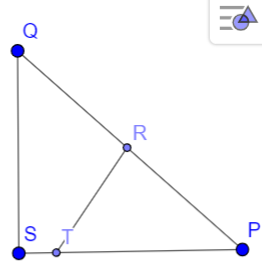
Let P be the point (3,0) and Q be a moving point (0,3t). Let PQ be trisected at R so that R is nearer to Q. RN is drawn perpendicular to PQ meeting the x-axis at N. The locus of the midpoint of RN is
(a) ${{\left( x+3 \right)}^{2}}-3y=0$
(b) \[{{\left( y+3 \right)}^{2}}-3x=0\]
(c) \[{{x}^{2}}-y=1\]
(d) \[{{y}^{2}}-x=1\]
Answer
554.7k+ views
Hint: Point of trisection means a point which exactly divides a line segment into three equal parts. Here, point R divides a line segment PQ into 3 parts but point R is closer to Q hence dividing the line segment PQ in a ratio of 2:1 internally. First we have to find out the point of division and then the locus of midpoint by applying the midpoint formula.
Complete step-by-step answer:

The point P which divides the line segment joining the points A \[\left( {{x}_{1,}}{{y}_{1}} \right)\], B \[\left( {{x}_{2}},{{y}_{2}} \right)\]in the ratio m:n internally is given by
P = \[\left( \dfrac{m{{x}_{2}}+n{{x}_{1}}}{m+n},\dfrac{m{{y}_{2}}+n{{y}_{1}}}{m+n} \right)\]
P(3,0) and Q(0,3t) are given. Now we have to find R which divides P and Q internally in the ratio 2:1.
R= \[\left( \dfrac{2(0)+1(-3)}{2+1},\dfrac{2(3t)+1(0)}{2+1} \right)\]
R = (-1,2t)
Now consider the point N as (x,0) because it is lying on the x axis and the line RN is perpendicular to PQ.
Slope of PQ $\times $slope of RN = -1
Because the product of slopes of two perpendicular lines is -1.
\[\dfrac{3t-0}{0-(-3)}\times \dfrac{2t-0}{-1-x}=-1\]
$\begin{align}
& 2{{t}^{2}}=x+1 \\
& x=2{{t}^{2}}-1 \\
\end{align}$
$\begin{align}
& 2{{t}^{2}}=x+1 \\
& x=2{{t}^{2}}-1 \\
\end{align}$
The point N is \[\left( 2{{t}^{2}}-1,0 \right)\]
The locus of midpoint of RN is
Formula for midpoint is: \[\left( \dfrac{{{x}_{1}}+{{x}_{2}}}{2},\dfrac{{{y}_{1}}+{{y}_{2}}}{2} \right)\]
The midpoint of RN is \[\left( \dfrac{2{{t}^{2}}-1+\left( -1 \right)}{2},\dfrac{2t+0}{2} \right)\]
(x,y) = \[\left( {{t}^{2}}-1,t \right)\]
Therefore y=t, x= \[{{t}^{2}}-1\]
\[\therefore \] \[x={{y}^{2}}-1\]
Therefore the option is d.
So, the correct answer is “Option d”.
Note: When two lines are perpendicular to each other the product of their slopes is equal to -1. R can divide P and Q in the ratio 1:2 and 2:1 internally. Here we have to take 2:1 because it was given that R is closer to Q.
Complete step-by-step answer:

The point P which divides the line segment joining the points A \[\left( {{x}_{1,}}{{y}_{1}} \right)\], B \[\left( {{x}_{2}},{{y}_{2}} \right)\]in the ratio m:n internally is given by
P = \[\left( \dfrac{m{{x}_{2}}+n{{x}_{1}}}{m+n},\dfrac{m{{y}_{2}}+n{{y}_{1}}}{m+n} \right)\]
P(3,0) and Q(0,3t) are given. Now we have to find R which divides P and Q internally in the ratio 2:1.
R= \[\left( \dfrac{2(0)+1(-3)}{2+1},\dfrac{2(3t)+1(0)}{2+1} \right)\]
R = (-1,2t)
Now consider the point N as (x,0) because it is lying on the x axis and the line RN is perpendicular to PQ.
Slope of PQ $\times $slope of RN = -1
Because the product of slopes of two perpendicular lines is -1.
\[\dfrac{3t-0}{0-(-3)}\times \dfrac{2t-0}{-1-x}=-1\]
$\begin{align}
& 2{{t}^{2}}=x+1 \\
& x=2{{t}^{2}}-1 \\
\end{align}$
$\begin{align}
& 2{{t}^{2}}=x+1 \\
& x=2{{t}^{2}}-1 \\
\end{align}$
The point N is \[\left( 2{{t}^{2}}-1,0 \right)\]
The locus of midpoint of RN is
Formula for midpoint is: \[\left( \dfrac{{{x}_{1}}+{{x}_{2}}}{2},\dfrac{{{y}_{1}}+{{y}_{2}}}{2} \right)\]
The midpoint of RN is \[\left( \dfrac{2{{t}^{2}}-1+\left( -1 \right)}{2},\dfrac{2t+0}{2} \right)\]
(x,y) = \[\left( {{t}^{2}}-1,t \right)\]
Therefore y=t, x= \[{{t}^{2}}-1\]
\[\therefore \] \[x={{y}^{2}}-1\]
Therefore the option is d.
So, the correct answer is “Option d”.
Note: When two lines are perpendicular to each other the product of their slopes is equal to -1. R can divide P and Q in the ratio 1:2 and 2:1 internally. Here we have to take 2:1 because it was given that R is closer to Q.
Recently Updated Pages
Master Class 11 Social Science: Engaging Questions & Answers for Success

Master Class 11 Physics: Engaging Questions & Answers for Success

Master Class 11 Maths: Engaging Questions & Answers for Success

Master Class 11 Economics: Engaging Questions & Answers for Success

Master Class 11 Computer Science: Engaging Questions & Answers for Success

Master Class 11 Chemistry: Engaging Questions & Answers for Success

Trending doubts
What is meant by exothermic and endothermic reactions class 11 chemistry CBSE

10 examples of friction in our daily life

Difference Between Prokaryotic Cells and Eukaryotic Cells

1 Quintal is equal to a 110 kg b 10 kg c 100kg d 1000 class 11 physics CBSE

One Metric ton is equal to kg A 10000 B 1000 C 100 class 11 physics CBSE

Draw a diagram of nephron and explain its structur class 11 biology CBSE




